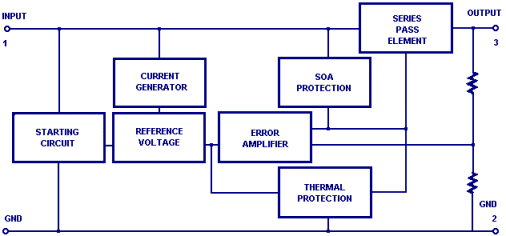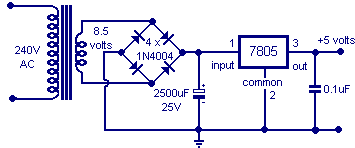
LM7805 Integrated Circuit Internal Schematic - Fairchild Semiconductors
VOLTAGE REGULATORS
A Voltage Regulator (also called a "regulator") has only three legs and appears to be a comparatively simple device but it is actually a very complex integrated circuit. A regulator converts varying input voltage and produces a constant "regulated" output voltage. Voltage regulators are available in a variety of outputs, typically 5 volts, 9 volts and 12 volts. The last two digits in the name indicate the output voltage.
| Name | Voltage |
| LM7805 | + 5 volts |
| LM7809 | + 9 volts |
| LM7812 | + 12 volts |
| LM7905 | - 5 volts |
| LM7909 | - 9 volts |
| LM7912 | - 12 volts |

LM7805 Integrated Circuit Internal Schematic - Fairchild
Semiconductors
The "LM78XX" series of voltage regulators are designed for positive input. For applications requiring negative input the "LM79XX" series is used.
Symbol for a Voltage
Regulator. |
 A LM7805 Regulator
|
 |
The circuit diagram below represents a typical use of a voltage regulator.
 The LM7805 can reliably deliver 1 amp at a constant voltage. |
How
it Works:
The transformer drops the 240 volt 'mains' voltage to 8.5 volts. The diode 'bridge'
rectifies the 8.5 volts AC from the output side of the power transformer into DC. The 2500uF capacitor helps to maintain a constant input
into the regulator.
As a general guide this capacitor should be rated at a minimum of 1000uF for each amp of current drawn and at least TWICE the input voltage. The 0.1uF capacitor eliminates any high frequency pulses that could otherwise interfere with the operation of the regulator.
Voltage regulators are very robust. They can withstand over-current draw due to short circuits and also over-heating. In both cases the regulator will shut down before damage occurs. The only way to destroy a regulator is to apply reverse voltage to its input.
Reverse polarity destroys the regulator almost instantly. To avoid this possibility you should always use diode protection of the power supply. This is especially important when using nine volt battery supplies as it is common for people to 'test' the battery by connecting it one way and then the other. Even this short 'test' could destroy the regulator if a protection diode is not used.
All of the interfaces described on this site have protection diodes connected into the power supply circuit to prevent damage due to incorrect polarity. Generally a 1N4004, 1 amp power diode is connected in series with the power supply. If the supply is connected the wrong way around, the regulator will be protected from damage.
|
Input Voltage:
As a general rule the input voltage should be limited to 2 to 3 volts above the
output voltage. The LM78XX series can handle up to 30 volts input, but the power
difference between the input voltage/current ratio and output voltage/current ratio
appears as heat. If the input voltage is unnecessarily high the regulator will get very
hot. Unless sufficient heat-sinking is provided the regulator will shut down.
The output current of a power supply based on a Voltage Regulator can be increased using a power transistor such as the 2955 series. These transistors can pass several amps quite safely.
|
It is possible to increase the output voltage of a Regulator circuit using a pair of 'voltage-divider' resistors (R1 and R2 in the diagram below), or a zener diode. It is not possible to obtain a voltage lower than the stated rating. You could not use a 12 volt regulator to make a 5 volt power supply, but you could use a 5 volt regulator to make a 12 volt supply.
If R1 is replaced with a suitable variable resistor ("potentiometer") it is possible to make a simple 'variable' power supply.
|
Some regulators are designed to produce a regulated voltage as low as 1.7 volts, for example the LM317. This type of regulator is ideal to use in 'variable' power supplies able to provide 1 amp regulated DC at voltages ranging from 1.7 to around 40 volts.
The interfaces described on this site are based on either 5 volt, or 12 volt integrated circuits. They use either LM7805, or LM7812 regulators.
Regulators - QUIZ